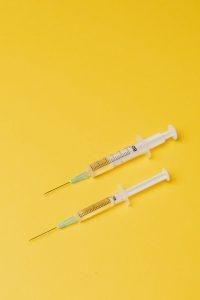Botulinum toxin, commonly known as Botox, is a neurotoxic protein produced by the bacterium Clostridium botulinum. The toxin is composed of a heavy chain (H) and a light chain (L), connected by a disulfide bond, and is produced as part of the bacterium’s metabolic pathway. The H chain contains the receptor-binding domain, while the L chain contains the enzymatic domain responsible for cleaving and inactivating the neuronal protein SNAP-25.
Botulinum toxin works by blocking neurotransmitter release at the neuromuscular junction. It does so by binding to the presynaptic nerve terminal and inhibiting the exocytosis of acetylcholine, leading to a temporary paralysis of the muscle fibers. This inhibition of neurotransmitter release is due to the cleavage of SNAP-25, which is essential for the docking and fusion of synaptic vesicles with the plasma membrane.
What else is in the Botox vial?
Botox vials typically contain the active ingredient, botulinum toxin type A, along with several excipients or inactive ingredients. These excipients may include saline, human albumin, and sodium chloride, which are used to stabilize the solution and adjust its osmotic pressure. The exact composition of the excipients can vary depending on the manufacturer and the specific formulation of Botox. Additionally, some formulations of Botox may contain other ingredients, such as preservatives or buffering agents, to further stabilize the solution and ensure its safety and efficacy.
pharmaceutical product in order to enhance its formulation, stability, delivery or overall efficacy. These substances play a critical role in determining the pharmacokinetics, pharmacodynamics and overall performance of the active pharmaceutical ingredient (API) in a drug.
Excipients can be used for various purposes in drug formulation, such as to improve the solubility and stability of the API, enhance its bioavailability, control its release rate, or provide a desired delivery system. Additionally, excipients can act as fillers, binders, lubricants, or preservatives, to improve the overall consistency, appearance, or stability of the product.
Excipients can impact the pharmacokinetics of the API by affecting the absorption, distribution, metabolism, and elimination of the drug, and in turn influence the safety and efficacy of the drug.
excipients can have a direct impact on the pharmacodynamics of the API, as they can alter the activity, potency, or receptor binding of the API, depending on the excipient profile and its interactions with the API. Excipients can also have an indirect impact on the pharmacodynamics of the API, as they can alter the physiological milieu in which the API is acting, such as by affecting the pH, ionic strength, or osmolarity of the product.
Excipients can cause adverse reactions in some patients, especially in individuals who are sensitive to certain ingredients.
What is the mechanism of action for Botox
The mechanism of action of botulinum toxin is highly specific and limited to a particular subset of neurons. This specificity arises from the presence of specific receptor proteins on the surface of the nerve terminal that are able to bind the toxin with high affinity. The binding of the toxin to the receptor leads to its internalization, which is followed by the translocation of the L chain to the cytoplasm. The L chain then cleaves SNAP-25, resulting in the inhibition of neurotransmitter release.
Botox is used medically to treat various conditions, such as muscle spasms, dystonias, blepharospasm, and strabismus. It is also used in cosmetics to temporarily reduce the appearance of facial wrinkles, fine lines, and crow’s feet. In these cosmetic applications, Botox is usually administered via intramuscular injections.
The use of Botox in medicine and cosmetics is based on the ability of the toxin to produce a local, temporary paralysis of the targeted muscle fibers. The duration of the effect of Botox depends on various factors, such as the dose of the toxin, the site of injection, the age and health of the patient, and the metabolic rate of the individual. The effects of Botox typically last for 3-6 months, after which the patient may require a repeat treatment.

The use of Botox is generally considered safe, but as with any medical treatment, there are certain risks associated with its use. Some of the common side effects of Botox include pain, swelling, and redness at the injection site, as well as headache, dizziness, and flu-like symptoms. In rare cases, patients may experience more serious side effects, such as botulism, a severe form of food poisoning caused by the bacterium Clostridium botulinum.
Botox is a neurotoxic protein produced by the bacterium Clostridium botulinum. Botox works by blocking neurotransmitter release at the neuromuscular junction, leading to a temporary paralysis of the muscle fibers. The mechanism of action of the toxin is highly specific and limited to a particular subset of neurons, and is based on the ability of the toxin to bind to specific receptor proteins on the nerve terminal. Botox is used medically to treat various conditions, such as muscle spasms, dystonias, and blepharospasm, and in cosmetics to temporarily reduce the appearance of facial wrinkles.
Find Botox near you.
Is there any connection whatsoever between botox and some kind of snake venom? It is something I think I have heard, but have forgotton what was said about it.
Comments are closed.